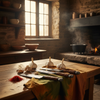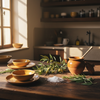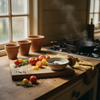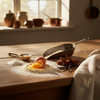Ounce Measuring Cup: Your Complete Kitchen Guide
Key Takeaways
- An ounce measuring cup allows for precise measurement of ingredients in fluid or weight ounces.
- It eliminates guesswork by providing accurate measurements for both liquids and dry goods.
- Ounce-marked cups offer more granular control compared to standard cup measurements.
- They are essential for recipes requiring exact amounts, such as 2 oz of vanilla extract or 6 oz of chocolate chips.
Table of Contents
- Ounce Measuring Cups: Precision Tools for Culinary Success
- Understanding Ounce to Cup Conversions
- Types of Ounce Measuring Cups and Their Applications
- Reading and Using an Ounce Measuring Cup
- Practical Applications and Solutions
- Choosing the Best Ounce Measuring Cup for Your Needs
- Digital Scales and Measuring Spoons: Precision Alternatives
- Troubleshooting Common Measuring Cup Issues
- The Role of Ounce Measuring Cups in Culinary Success
- Maintenance and Storage for Long-Term Performance
- Professional Kitchen Standards vs Home Use
- Emerging Trends in Kitchen Measurement Technology
- Final Recommendations for Measuring Success
Ounce Measuring Cups: Precision Tools for Culinary Success
An ounce measuring cup transforms guesswork into precision, measuring ingredients in fluid ounces for liquids or weight ounces for dry goods. Unlike standard cup measurements, ounce-marked cups provide granular control, essential when a recipe calls for 2 oz of vanilla extract or 6 oz of chocolate chips.
For those seeking reliable tools, a 4-piece stainless steel measuring cup set offers both durability and accuracy for everyday cooking and baking needs.
The distinction between fluid and weight ounces matters. Fluid ounces measure volume (8 fluid ounces = 1 cup), while weight ounces measure mass (varies by ingredient density). Professional bakers rely on this precision because a 2 oz measuring cup of flour differs significantly from 2 weight ounces of flour. If you want a comprehensive set for all your measuring needs, consider the 8-piece 18/8 stainless steel measuring cup and spoon set for versatility in the kitchen.
Understanding Ounce to Cup Conversions

The standard conversion, 1 cup equals 8 fluid ounces, forms the foundation of recipe accuracy. This relationship means your 8 oz measuring cup equals exactly one standard cup, while a 1 ounce measuring cup represents 1/8 of a standard cup or 2 tablespoons.
Recipe precision depends on these conversions. When scaling a cocktail recipe calling for 1.5 oz of bourbon, using an oz measuring cup for cocktails ensures consistent flavor profiles. Misconversions create dense cakes, weak drinks, or oversalted dishes, problems that proper measuring tools eliminate.
Types of Ounce Measuring Cups and Their Applications
Liquid measuring cups feature spouts and clear markings for fluid ounces, designed for pourable ingredients like oils, broths, and spirits. Their transparent construction allows meniscus reading, the curved liquid surface that indicates accurate measurement when read at eye level.
Dry measuring cups, typically made from metal or sturdy plastic, work best for ingredients you can level off. An oz measuring cup plastic version offers durability for frequent use, while glass provides chemical resistance and temperature stability. For more on the advantages of plastic options, see this plastic measuring cups guide.
Specialized cocktail jiggers combine multiple measurements in one tool, often featuring 1 oz and 2 oz sides. These double-ended cups eliminate guesswork in mixology, where precision affects taste balance.
Material choice impacts performance: glass resists staining and odors, metal provides durability, and plastic offers lightweight convenience. Professional kitchens often stock all three types for different applications.
Reading and Using an Ounce Measuring Cup
Accurate liquid measurement requires reading the meniscus at eye level. Place the cup on a flat surface, pour slowly, and read where the bottom of the liquid's curve aligns with the measurement line. This technique prevents the parallax error that occurs when reading from above.
For dry ingredients, fill slightly above the desired line, then level with a straight edge. This method works particularly well with an ounce measuring spoon for smaller quantities, ensuring consistent results in baking where precision affects texture.
Regular calibration maintains accuracy. Test your measuring cup by filling it with water and weighing the result, 8 fluid ounces should weigh approximately 8 ounces on a kitchen scale, accounting for minor variations in water temperature.
Practical Applications and Solutions

Faded markings plague older measuring cups, but simple solutions restore functionality. Use a permanent marker to retrace visible lines, or apply small adhesive measurement labels. For emergency situations without proper tools, remember that a standard shot glass holds 1.5 oz, while a tablespoon equals 0.5 oz.
Measuring sticky liquids like honey or molasses requires technique. Lightly coat your ounce measuring cup with cooking spray before pouring, the ingredient releases cleanly, ensuring accurate measurement and easy cleanup.
Cracked measuring cups compromise accuracy and harbor bacteria. Replace immediately rather than risk contamination. Glass cups withstand thermal shock better than plastic, making them ideal for measuring hot liquids like melted butter or warm broths. If you’re interested in the benefits of glass, check out this glass measuring cup article.
Fractional measurements demand precision. When recipes call for 1.5 oz, use a 2 oz measuring cup filled three-quarters full, or combine 1 oz plus 0.5 oz (1 tablespoon) for exact results. This technique prevents waste and maintains recipe integrity.
Choosing the Best Ounce Measuring Cup for Your Needs
Material durability determines longevity. Glass measuring cups resist staining and maintain clear markings longer, while heavy-duty plastic versions offer shatter resistance for busy kitchens. Metal cups provide professional-grade durability but limit visibility during measuring.
| Feature | Glass | Plastic | Metal |
|---|---|---|---|
| Heat Resistance | High (up to 400°F) | Moderate (varies) | Excellent |
| Marking Clarity | Permanent etching | Printed (may fade) | Stamped/etched |
| Dishwasher Safe | Yes | Usually | Yes |
| Break Resistance | Low | High | Highest |
For baking precision, choose cups with multiple measurement scales, both ounces and milliliters provide conversion flexibility. Spout design matters for liquid ingredients; wide spouts offer control for thick batters, while narrow spouts excel with thin liquids.
Professional brands like Pyrex offer heat-resistant borosilicate glass that withstands temperature changes, while OXO provides ergonomic grips and clear measurement markings. Budget options work adequately for occasional use, but frequent bakers benefit from investing in quality construction that maintains accuracy over time. If you want to browse a variety of options, explore the measuring cups collection for different materials and styles.
Digital Scales and Measuring Spoons: Precision Alternatives
Digital scales surpass measuring cups for ultimate precision, especially with dry ingredients. A scale eliminates density variables, 4 oz of flour weighs exactly 4 oz regardless of how it's packed, while volume measurements can vary by 20% based on sifting and settling.
An ounce measuring spoon set bridges the gap between standard teaspoons and full measuring cups. These specialized tools handle small liquid quantities, perfect for extracts, oils, or cocktail bitters where a 1 ounce measuring cup might prove too large for comfortable handling. For a complete set of spoons, try the 4-piece 18/8 stainless steel measuring spoon set for accuracy with small amounts.
Troubleshooting Common Measuring Cup Issues

Sticky residue from honey, molasses, or oils requires targeted cleaning. Soak in warm, soapy water, then use baking soda paste for stubborn buildup. Avoid abrasive scrubbers on plastic surfaces, which can scratch measurement markings and harbor bacteria.
Reading measurements on opaque or tinted cups demands strategic lighting. Hold the cup against a light source or use a flashlight to illuminate internal markings. Consider replacing opaque cups with clear alternatives for consistent accuracy.
Converting between measurement systems becomes intuitive with practice. Remember that 30ml equals approximately 1 fluid ounce, while 15ml equals 1 tablespoon. Keep a conversion chart nearby until these relationships become automatic, precision in measurement translates directly to consistent cooking results. For more on measurement conversions and best practices, see this comprehensive measuring tools guide.
The Role of Ounce Measuring Cups in Culinary Success
Measurement accuracy directly impacts cooking outcomes. Too little liquid creates dry, crumbly textures in baked goods, while excess liquid produces dense, soggy results. An ounce measuring cup provides the precision that transforms good recipes into consistently excellent dishes.
Every complete kitchen requires multiple measuring tools, standard cups for large quantities, ounce-marked cups for precision work, and measuring spoons for small amounts. This combination handles any recipe requirement while maintaining the accuracy that separates amateur cooking from professional-quality results. Store measuring cups nested together in a drawer or hung on hooks for easy access during cooking sessions. For more on the benefits of metal options, read this metal measuring cups overview.
Maintenance and Storage for Long-Term Performance
Proper storage extends measuring cup lifespan significantly. Nest cups together with protective cloth between glass pieces to prevent chipping, or hang individual cups on hooks for instant access and damage prevention. Avoid overcrowded drawers where cups bang against other utensils.
Pro Storage Tip: Store your ounce measuring cup set near your mixing station, not buried in deep cabinets. Accessible tools encourage accurate measuring, while hidden tools tempt shortcuts that compromise results.
Regular calibration checks maintain accuracy. Fill your cup with water, then weigh on a digital scale, 1 fluid ounce should equal approximately 29.6 grams. Replace any cup showing more than 5% deviation, as even small inaccuracies compound across complex recipes.
Hand-washing preserves measurement markings longer than dishwasher cycles. Hot water and gentle soap remove residue without the harsh detergents and high heat that fade printed measurements on oz measuring cup plastic versions. Glass and metal cups handle dishwashers better but still benefit from gentle treatment. For more on measurement accuracy, see this accurate stainless steel measuring cups article.
Professional Kitchen Standards vs Home Use

Commercial kitchens demand different precision levels than home cooking. Professional bakers often use weight measurements exclusively, while home cooks rely more heavily on volume measurements like those provided by measuring cups. Understanding this distinction helps choose appropriate tools for your skill level and cooking frequency.
Restaurant-grade measuring cups feature reinforced construction and permanent markings that withstand constant use. Home versions prioritize affordability and basic functionality, making them perfectly adequate for occasional baking but potentially limiting for serious culinary enthusiasts who cook daily.
Temperature resistance becomes crucial for professional applications. An oz measuring cup for cocktails in a busy bar must handle hot simple syrups and cold ingredients repeatedly, while home bartenders need less durability. Choose tools that match your usage intensity rather than over-engineering for casual needs. For a broader look at measurement standards, you can also refer to this authoritative resource on measurement conversions.
Emerging Trends in Kitchen Measurement Technology
Smart measuring cups with digital displays are entering the market, offering precise measurements without reading meniscus lines. These battery-powered tools display exact volumes on LCD screens, eliminating guesswork for visually impaired users or poorly lit kitchens.
Sustainable materials gain popularity as environmental awareness grows. Bamboo-fiber measuring cups and recycled plastic options provide eco-friendly alternatives without sacrificing functionality. These materials often feature naturally antimicrobial properties, reducing bacteria growth compared to traditional plastics.
Integration with recipe apps represents the next evolution. Some manufacturers develop measuring cups that connect to smartphones, automatically adjusting recipe quantities based on serving size changes. While currently expensive, this technology will likely become mainstream as costs decrease and accuracy improves.
Final Recommendations for Measuring Success
Investment in quality measuring tools pays dividends in consistent cooking results. A complete set including 1 ounce measuring cup, 2 oz measuring cup, and 8 oz measuring cup sizes handles most recipe requirements while maintaining the precision that separates good cooks from great ones. For a curated selection of top-rated kitchen tools, browse the award winning kitchen utensils collection.
The perfect ounce measuring cup combines clear markings, appropriate material for your cooking style, and comfortable handling. Glass excels for heat resistance and longevity, plastic offers safety in busy kitchens, and metal provides professional durability. Choose based on your primary use cases rather than trying to find one cup that does everything adequately.
Accurate measurement forms the foundation of culinary success. Whether crafting delicate pastries that demand precision or mixing cocktails that require exact ratios, the right measuring tools transform uncertainty into confidence. Your kitchen deserves instruments that match your culinary ambitions, invest accordingly, and taste the difference precision makes.
Frequently Asked Questions
What is the difference between fluid ounces and weight ounces when using an ounce measuring cup?
Fluid ounces measure the volume of a liquid ingredient, while weight ounces measure the mass of a dry ingredient. This distinction is important because 8 fluid ounces equals 1 cup by volume, but 8 weight ounces can vary depending on the ingredient's density.
How do ounce measuring cups improve accuracy compared to standard cup measurements in recipes?
Ounce measuring cups provide more granular control by marking precise fluid or weight ounces, eliminating guesswork. This accuracy is essential for recipes requiring exact amounts, ensuring consistent results whether measuring liquids like vanilla extract or dry goods like chocolate chips.
What types of ounce measuring cups are best suited for measuring liquids versus dry ingredients?
Clear, liquid ounce measuring cups with spouts are ideal for accurately pouring and measuring fluids, while stainless steel or solid material measuring cups marked in weight ounces work best for dry ingredients. Some ounce measuring cups feature dual markings to handle both types effectively.
How can I choose the most suitable ounce measuring cup material for my cooking or baking needs?
Choose stainless steel ounce measuring cups for durability, precision, and easy cleaning, especially for dry ingredients. For liquids, clear plastic or glass cups with fluid ounce markings and pouring spouts offer visibility and convenience. Consider your cooking style and maintenance preferences to find the best fit.



